The Tokyo cityscape becomes the ultimate light show in this video for "I Will Be Here," the recent collaboration single by Dutch DJ Tiësto and Australian dance music group Sneaky Sound System. Directed by Masashi Muto.
+ Video
The Tokyo cityscape becomes the ultimate light show in this video for "I Will Be Here," the recent collaboration single by Dutch DJ Tiësto and Australian dance music group Sneaky Sound System. Directed by Masashi Muto.
+ Video
Yōkai Daizukai, an illustrated guide to yōkai authored by manga artist Shigeru Mizuki, features a collection of cutaway diagrams showing the anatomy of 85 traditional monsters from Japanese folklore (which also appear in Mizuki's GeGeGe no Kitarō anime/manga). Here are a few illustrations from the book.
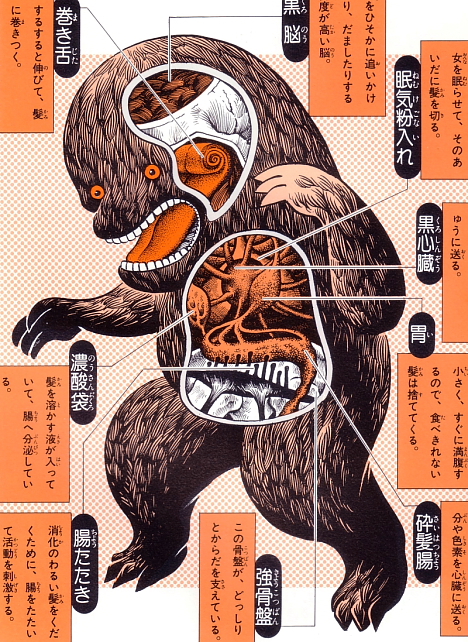
Kuro-kamikiri [+]
The Kuro-kamikiri ("black hair cutter") is a large, black-haired creature that sneaks up on women in the street at night and surreptitiously cuts off their hair. Anatomical features include a brain wired for stealth and trickery, razor-sharp claws, a long, coiling tongue covered in tiny hair-grabbing spines, and a sac for storing sleeping powder used to knock out victims. The digestive system includes an organ that produces a hair-dissolving fluid, as well as an organ with finger-like projections that thump the sides of the intestines to aid digestion.
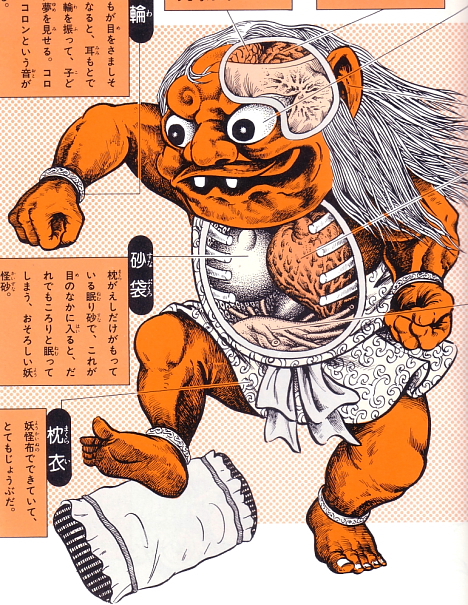
Makura-gaeshi [+]
The Makura-gaeshi ("pillow-mover") is a soul-stealing prankster known for moving pillows around while people sleep. The creature is invisible to adults and can only be seen by children. Anatomical features include an organ for storing souls stolen from children, another for converting the souls to energy and supplying it to the rest of the body, and a pouch containing magical sand that puts people to sleep when it gets in the eyes. In addition, the monster has two brains -- one for devising pranks, and one for creating rainbow-colored light that it emits through its eyes.
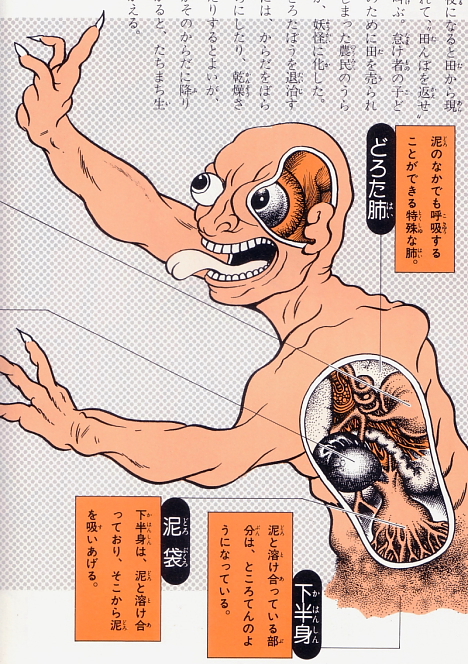
Doro-ta-bō [+]
The Doro-ta-bō ("muddy rice field man"), a monster found in muddy rice fields, is said to be the restless spirit of a hard-working farmer whose lazy son sold his land after he died. The monster is often heard yelling, "Give me back my rice field!" Anatomical features include a gelatinous lower body that merges into the earth, a 'mud sac' that draws nourishment from the soil, lungs that allow the creature to breathe when buried, and an organ that converts the Doro-ta-bō's resentment into energy that heats up his muddy spit. One eyeball remains hidden under the skin until the monster encounters the owner of the rice field, at which time the eye emerges and emits a strange, disorienting light.
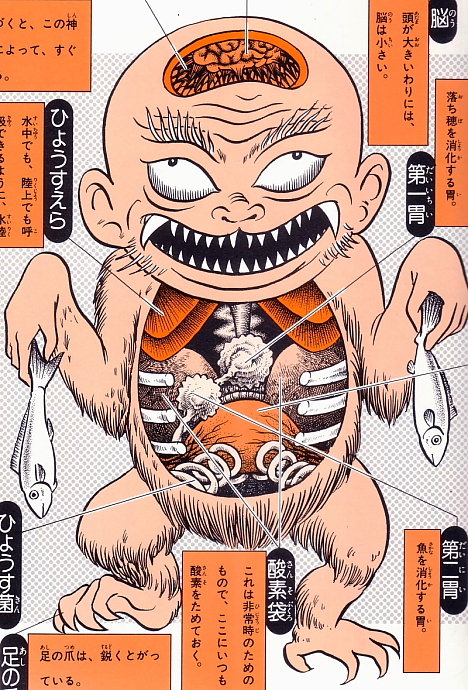
Hyōsube [+]
The Hyōsube, a child-sized river monster (a relative of the kappa) from Kyushu that lives in underwater caves, ventures onto land at night to eat rice plants. The monster has a relatively small brain, a nervous system specialized in detecting the presence of humans, thick rubbery skin, sharp claws, two small stomachs (one for rice grains and one for fish), a large sac for storing surplus food, and two large oxygen sacs for emergency use. A pair of rotating bone coils produce an illness-inducing bacteria that the monster sprinkles on unsuspecting humans.
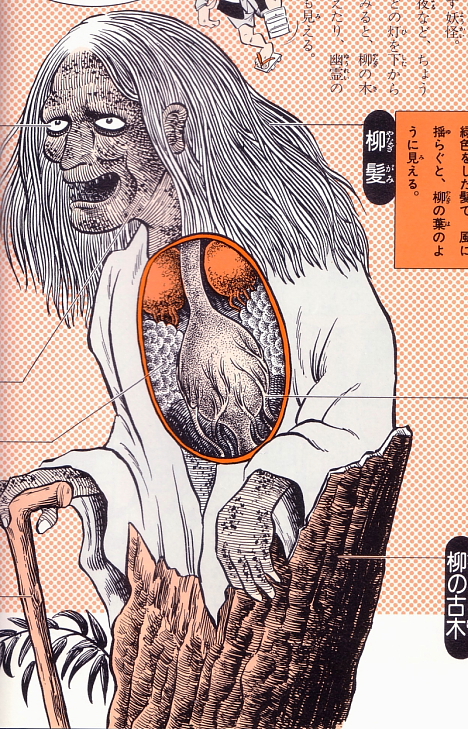
Yanagi-baba [+]
Yanagi-baba ("willow witch") is the spirit of 1,000-year-old willow tree. Anatomical features include long, green hair resembling leafy willow branches, wrinkled bark-like skin, a stomach that supplies nourishment directly to the tree roots, a sac for storing tree sap, and a cane cut from the wood of the old tree. Although Yanagi-baba is relatively harmless, she is known to harass passersby by snatching umbrellas into her hair, blowing fog out through her nose, and spitting tree sap.
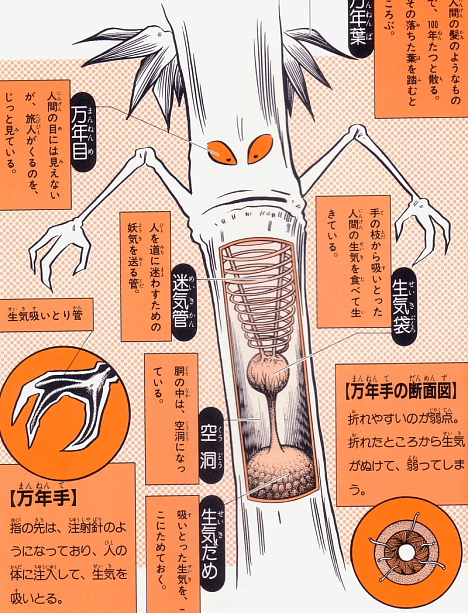
Mannen-dake [+]
The Mannen-dake ("10,000-year bamboo") is a bamboo-like monster that feeds on the souls of lost travelers camping in the woods. Anatomical features include a series of tubes that produce air that causes travelers to lose their way, syringe-like fingers the monster inserts into victims to suck out their souls, and a sac that holds the stolen souls.
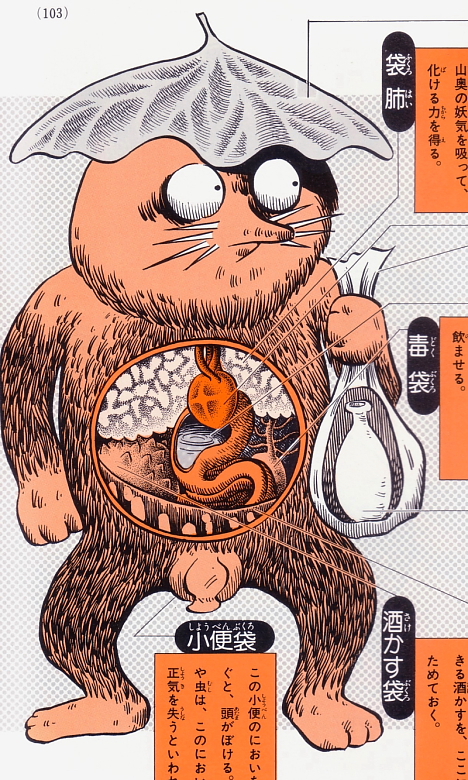
Fukuro-sage [+]
The Fukuro-sage -- a type of tanuki (raccoon dog) found in Nagano prefecture and Shikoku -- has the ability to shapeshift into a sake bottle, which is typically seen rolling down sloping streets. The bottle may pose a danger to people who try to follow it downhill, as it may lead them off a cliff or into a ditch. The Fukuro-sage usually wears a large potato leaf or fern leaf on its head and carries a bag made from human skin. The bag contains a bottle of poison sake. Anatomical features include a stomach that turns food into sake, a sac for storing poison that it mixes into drinks, and a pouch that holds sake lees. The Fukuro-sage's urine has a powerful smell that can disorient humans and render insects and small animals unconscious.
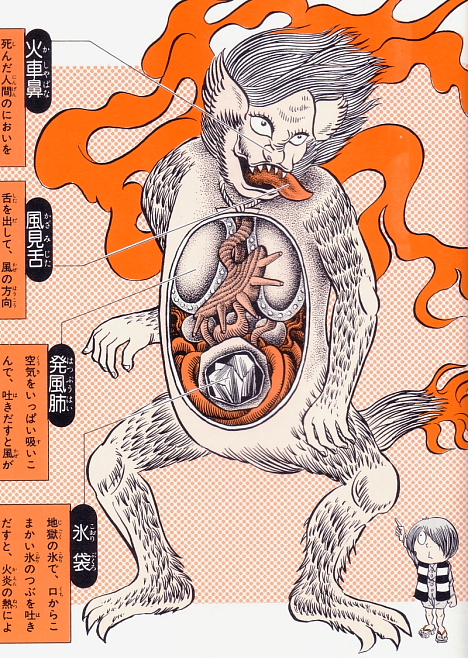
Kasha [+]
Kasha, a messenger of hell, is a fiery monster known for causing typhoons at funerals. Anatomical features include powerful lungs for generating typhoon-force winds that can lift coffins and carry the deceased away, as well as a nose for sniffing out funerals, a tongue that can detect wind direction, and a pouch containing ice from hell. To create rain, the Kasha spits chunks of this ice through its curtain of perpetual fire.
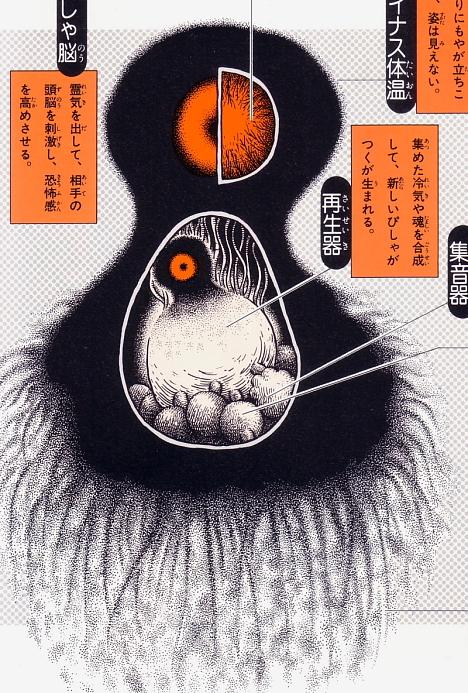
Bisha-ga-tsuku [+]
The Bisha-ga-tsuku is a soul-stealing creature encountered on dark snowy nights in northern Japan. The monster -- which maintains a body temperature of -150 degrees Celsius -- is constantly hidden behind a fog of condensation, but its presence can be detected by the characteristic wet, slushy sound ("bisha-bisha") it makes. Anatomical features include feelers that inhale human souls and cold air, a sac for storing the sounds of beating human hearts, and a brain that emits a fear-inducing aura. The Bisha-ga-tsuku reproduces by combining the stolen human souls with the cold air it inhales.
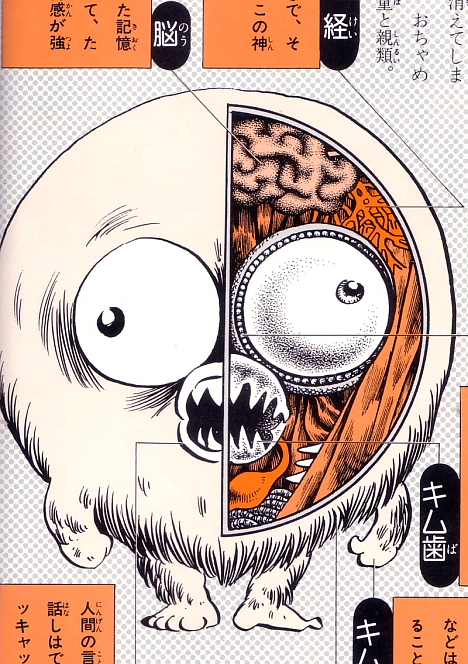
Kijimunaa [+]
The Kijimunaa is a playful forest sprite inhabiting the tops of Okinawan banyan trees. Anatomical features include eye sockets equipped with ball bearings that enable the eyeballs to spin freely, strong teeth for devouring crabs and ripping out the eyeballs of fish (a favorite snack), a coat of fur made from tree fibers, and a nervous system adapted for carrying out pranks. The Kijimunaa's brain contains vivid memories of being captured by an octopus -- the only thing it fears and hates.
[Source: Shigeru Mizuki's Yōkai Daizukai, 2004]
+ See also: Kaiju anatomical drawings
The University of Hawaii at Manoa hosts an online collection of about 1,500 magic lantern slides created in the 1930s and distributed around the world to educate people about Japan. Here are a few.
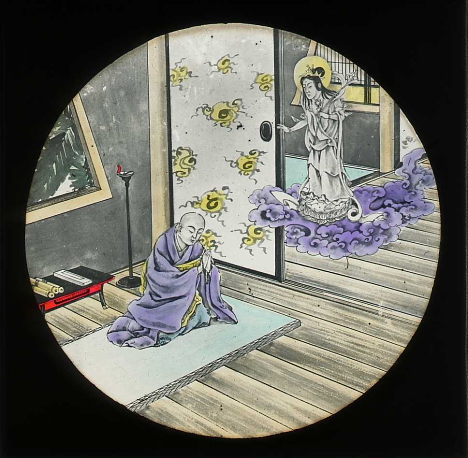
Buddhist story [+]
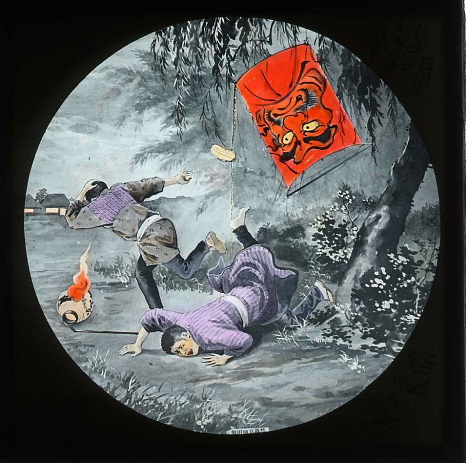
Scary kite [+]
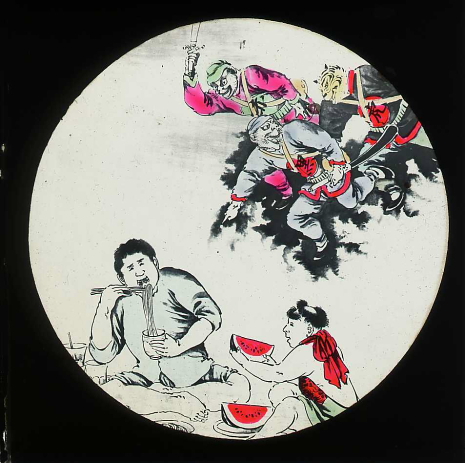
Sanitation campaign [+]
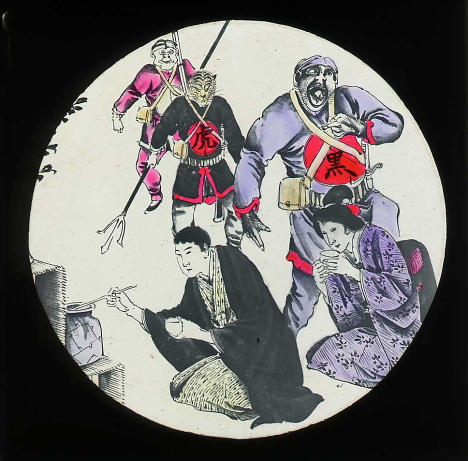
Sanitation campaign [+]
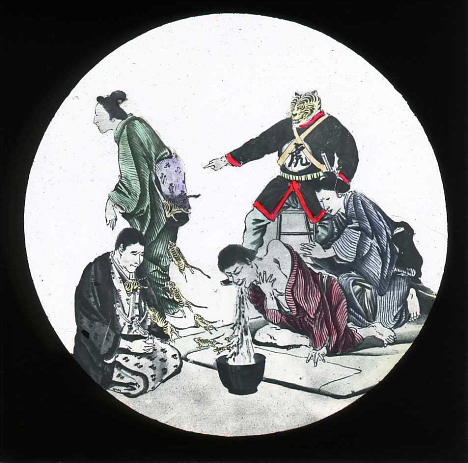
Sanitation campaign [+]
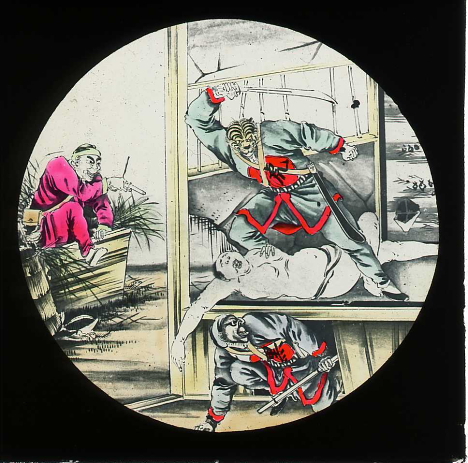
Sanitation campaign [+]
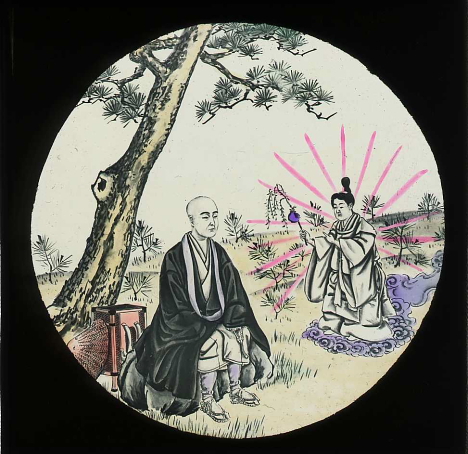
Buddhist story [+]
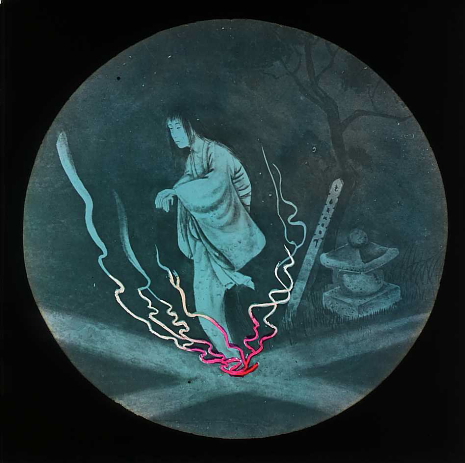
Story [+]
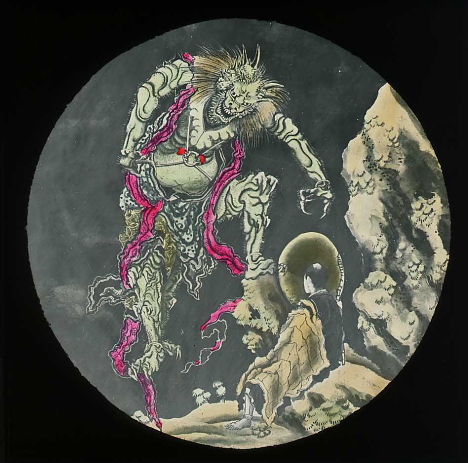
Buddhist story [+]
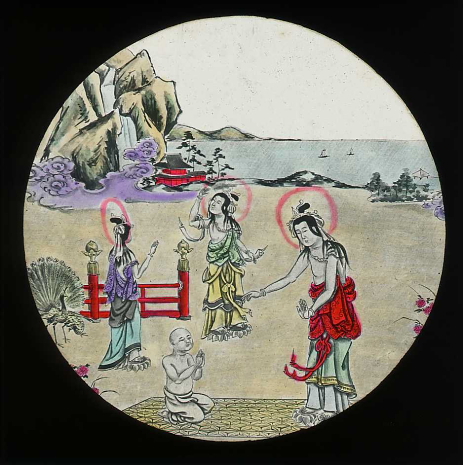
Buddhist story [+]
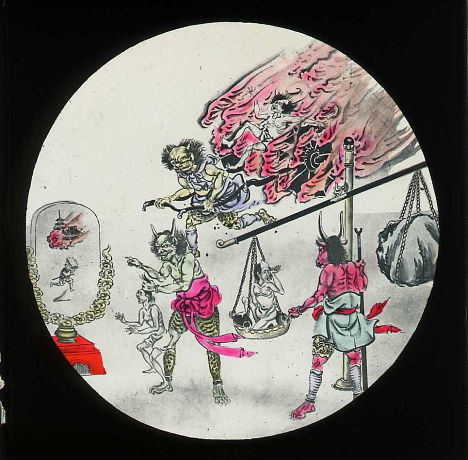
Hell [+]
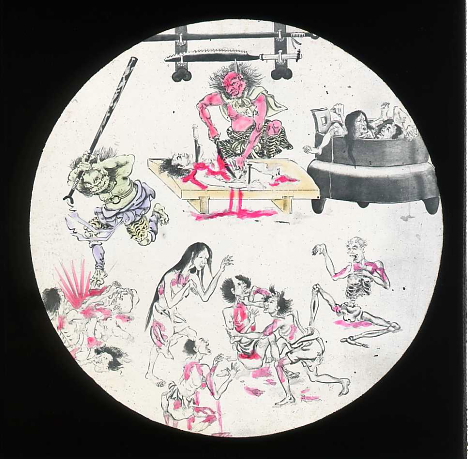
Hell [+]
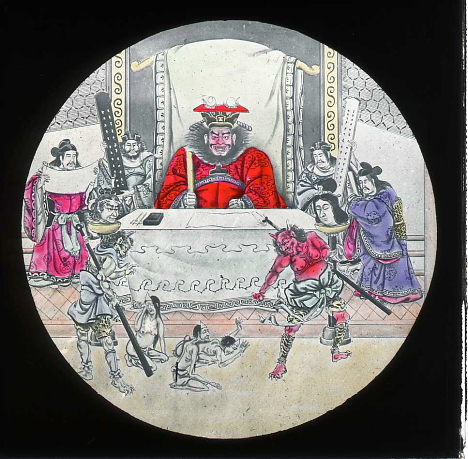
Hell [+]
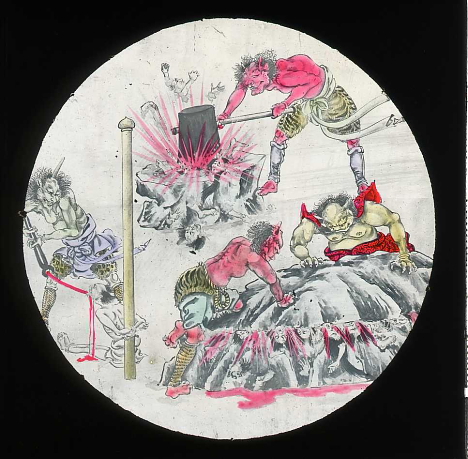
Hell [+]
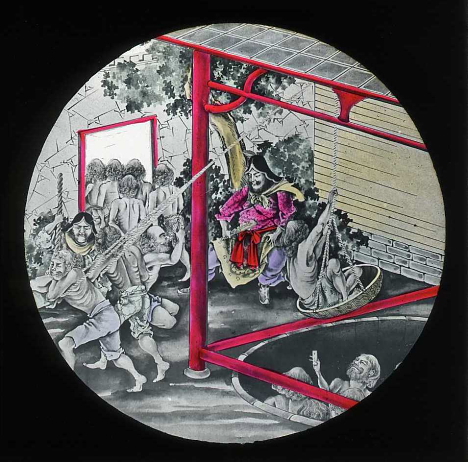
Hell [+]
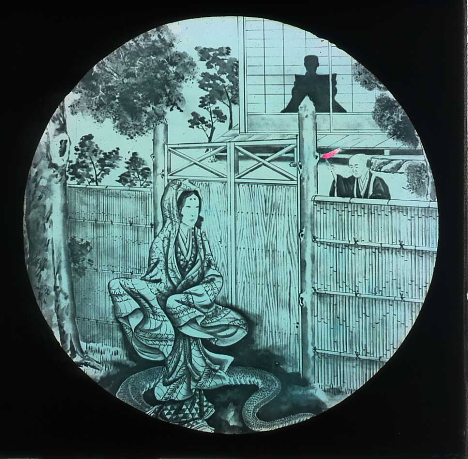
Snake woman [+]
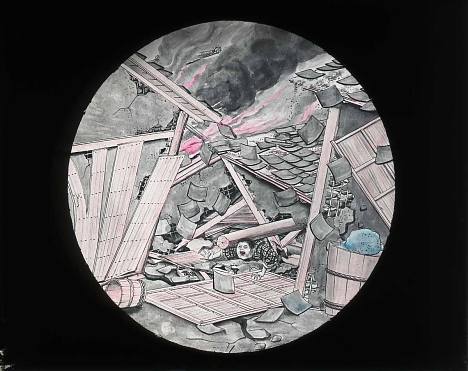
Earthquake [+]
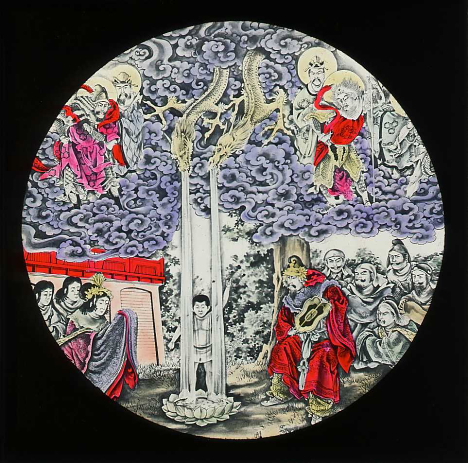
Buddhist story [+]
[UHM Magic Lantern Slides Collection via ephemera assemblyman]
Electric transformer boxes painted with the silhouettes of Ultraman monsters can be seen on the streets of Sukagawa (Fukushima prefecture), the hometown of sci-fi special effects master Eiji Tsuburaya.
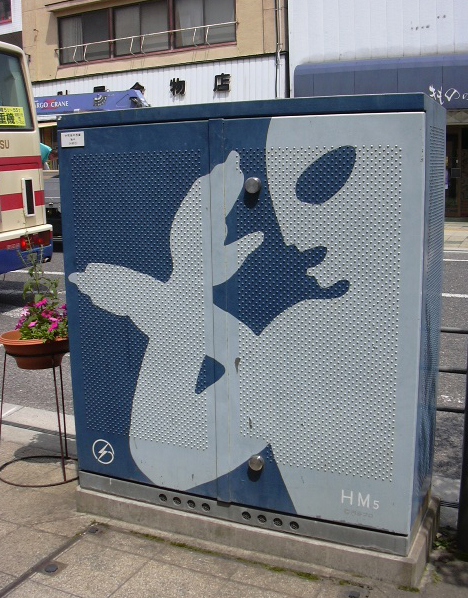
Ultraman [photo]
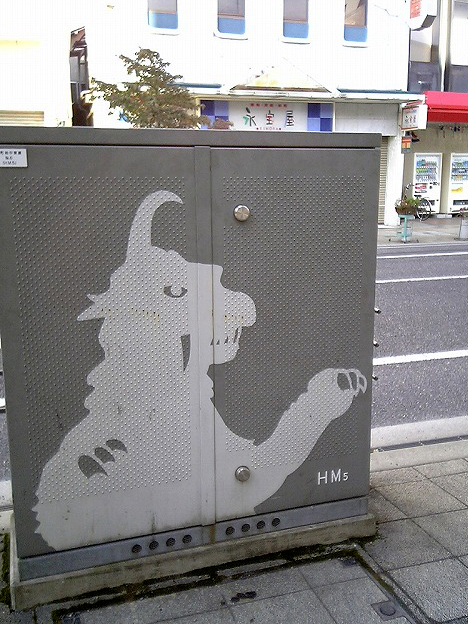
Gomess [photo]
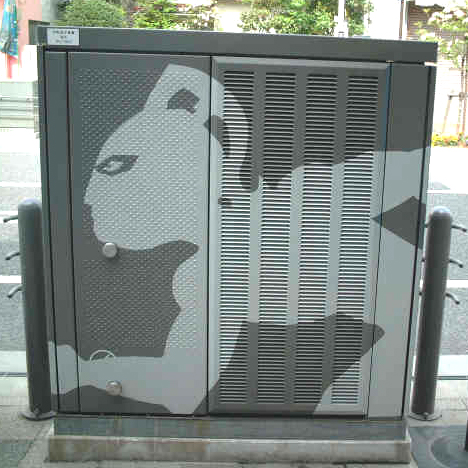
Ultra Seven [photo]
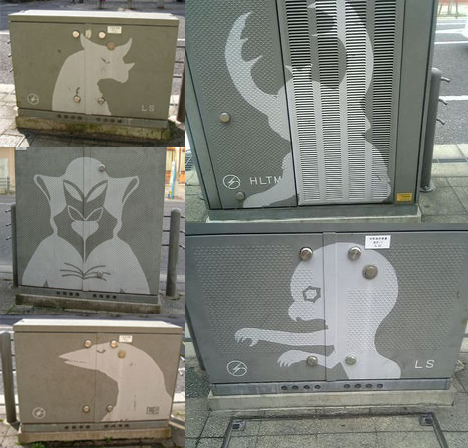
Clockwise from top-right: Antlar, Guts Seijin, Telesdon, Mephilas, Gomora [photo]
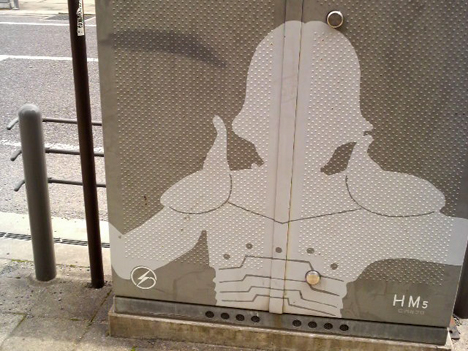
Borg Seijin [photo]
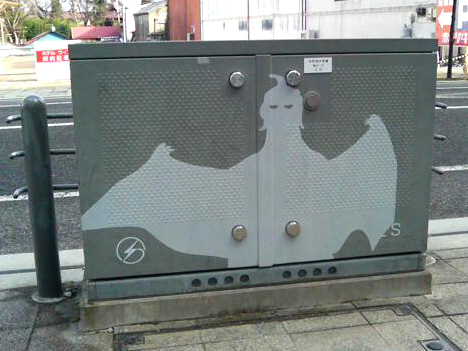
Pegira [photo]
Interactive media artist Mio I-zawa's "mechanical tumor" is a quivering hunk of fleshy, organic-looking material that expands and contracts depending on the amount of stress your computer is experiencing.
+ Video
Equipped with a series of motors and pneumatic actuators, the mechanical tumor pulsates gently when the CPU load is low. When the CPU load is high, the tumor's air compressor is activated, causing the lump of flesh to inflate.
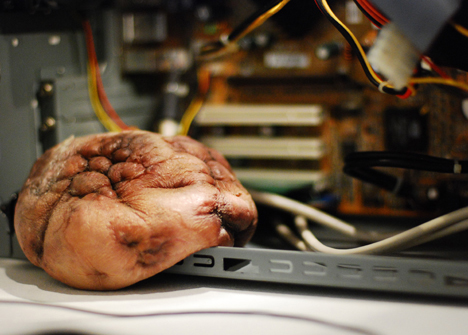
The size of the tumor fluctuates according to the CPU utilization rate, giving the user a very tangible reading of the computer's stress level.
* * * * *
Other biologically inspired interactive devices by Mio I-zawa include "external heart," a squishy latex heart on wheels that beats and rolls around in sync with the user's pulse...
...and "elastic cell," a system of 46 soft pulsating cells that react to human touch in a complex, lifelike way.
[Link: Mio I-zawa]
Here are a few samples of Japanese graphic design featured in the "Design X" special anniversary edition of IDEA magazine, 1995.
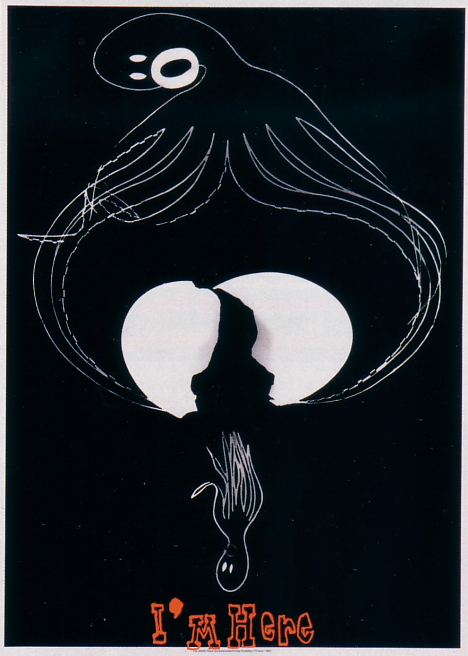
"I'm Here" poster, Katsuhiko Shibuya [+]
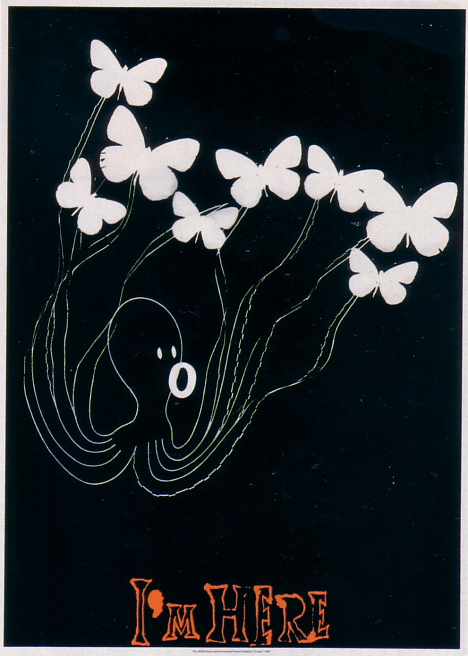
"I'm Here" poster, Katsuhiko Shibuya [+]
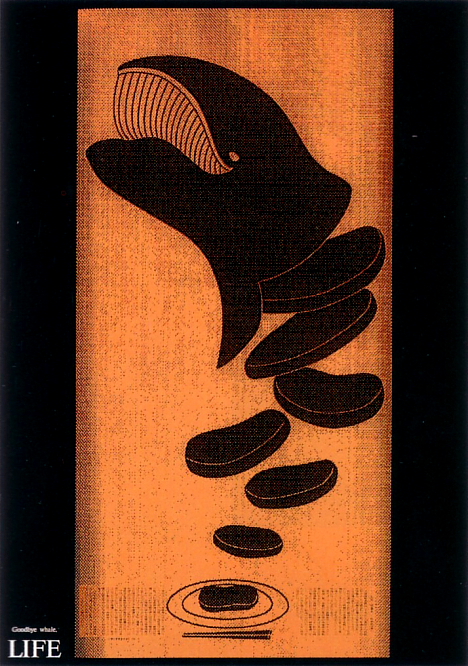
Poster for "Life" exhibition, Mamoru Suzuki, 1994 [+]
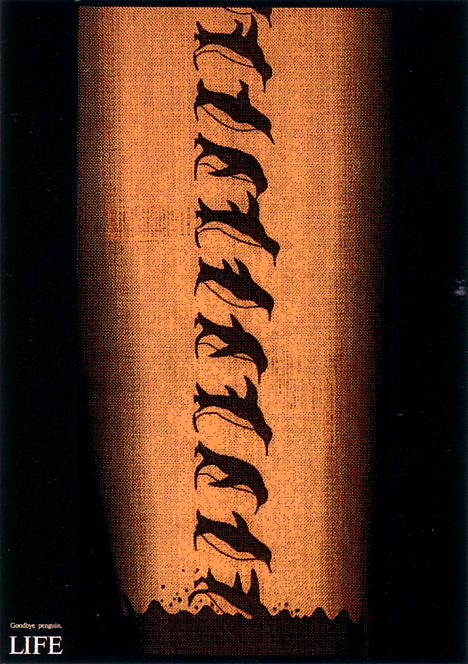
Poster for "Life" exhibition, Mamoru Suzuki, 1994 [+]
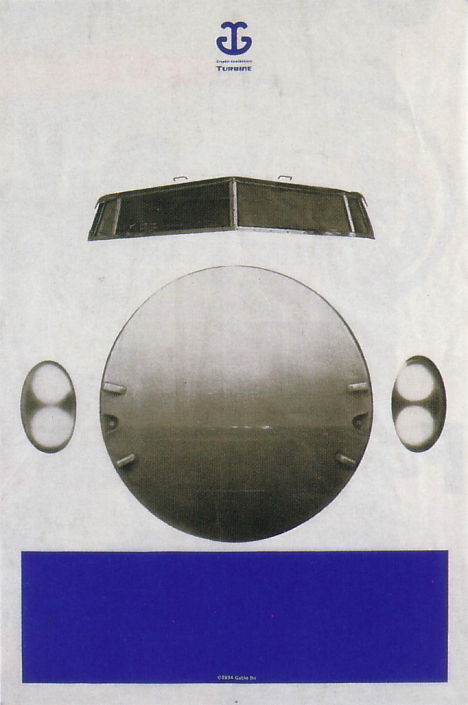
Garbage bag design, Gento Matsumoto, 1994 [+]
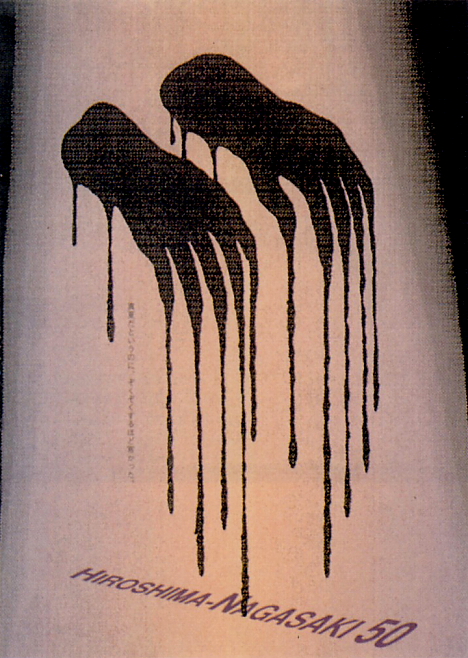
"Hiroshima-Nagasaki 50" poster for JAGDA exhibit, Mamoru Suzuki, 1995 [+]
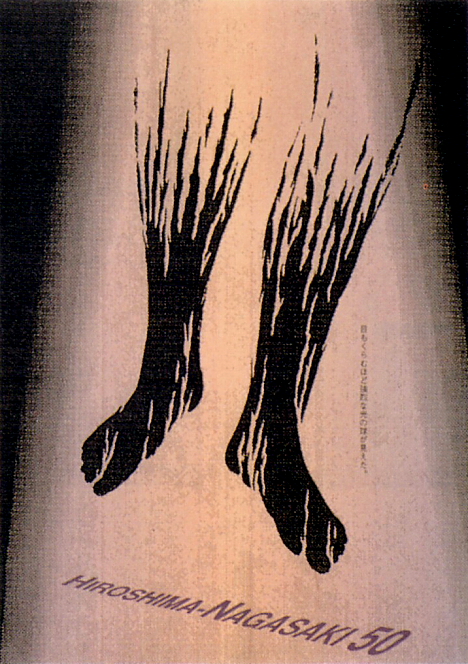
"Hiroshima-Nagasaki 50" poster for JAGDA exhibit, Mamoru Suzuki, 1995 [+]
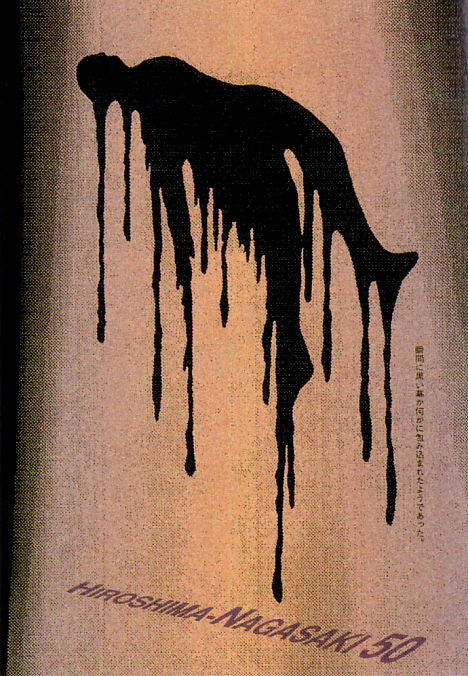
"Hiroshima-Nagasaki 50" poster for JAGDA exhibit, Mamoru Suzuki, 1995 [+]
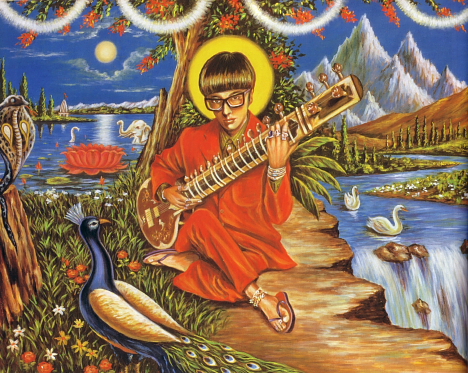
Iconova - Portrait of Towa Tei, Keiji Itoh, 1994 [+]
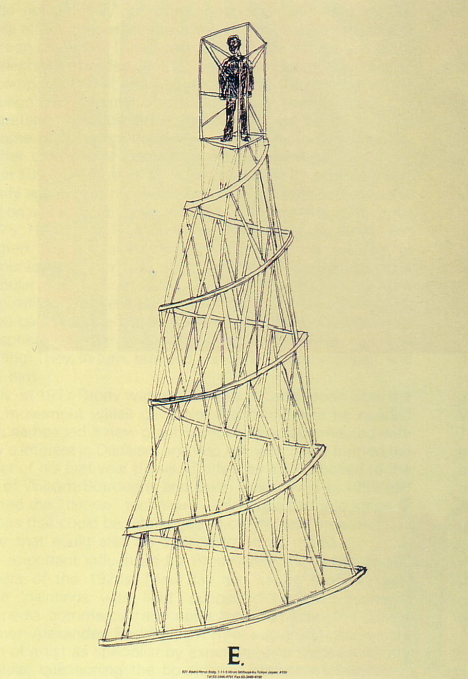
Poster for E Company, Tatsuo Ebina, 1993 [+]
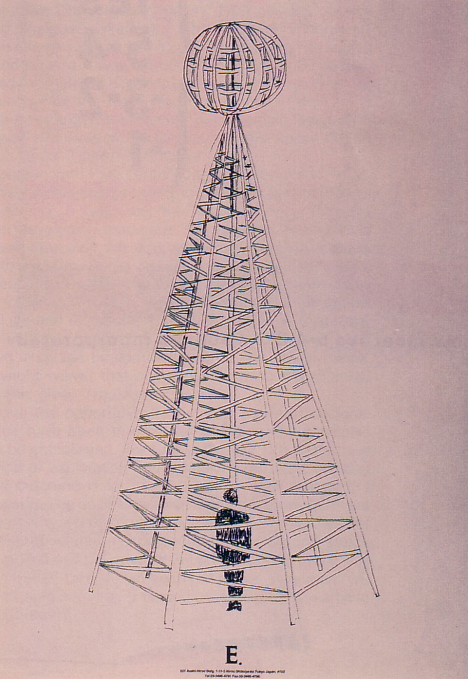
Poster for E Company, Tatsuo Ebina, 1993 [+]
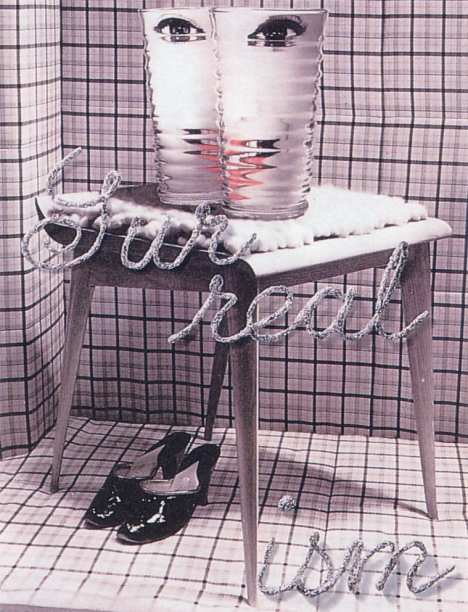
Editorial design for Hanatsubuki magazine, Katsuhiko Shibuya [+]
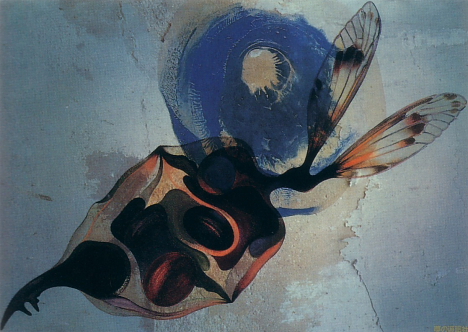
Poster for Yume-No-Yuminsha theatrical troupe, Noriyuki Tanaka, 1989 [+]
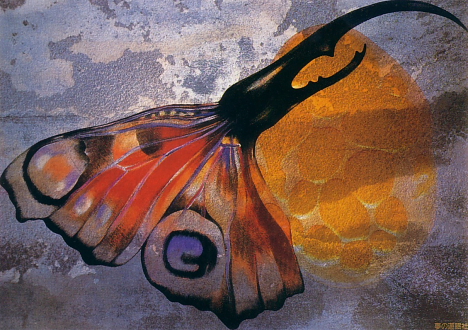
Poster for Yume-No-Yuminsha theatrical troupe, Noriyuki Tanaka, 1989 [+]
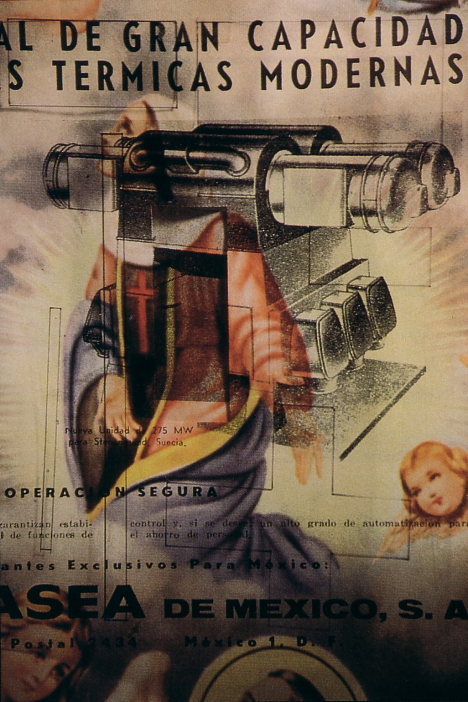
"Life/Elements" poster for "Life" exhibition, Keiji Itoh, 1994 [+]
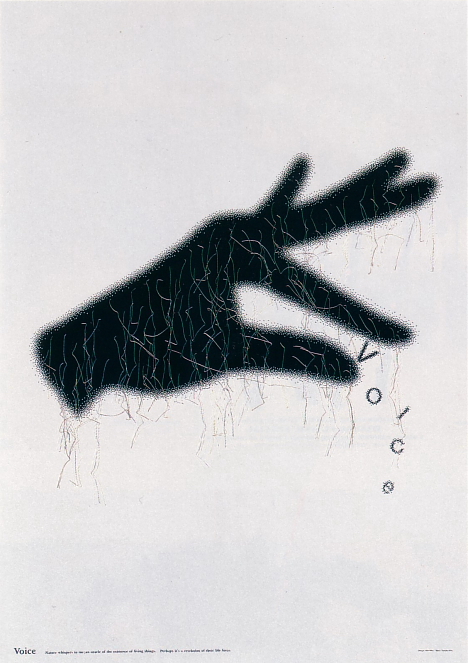
Voice, Ken Miki, 1993 [+]
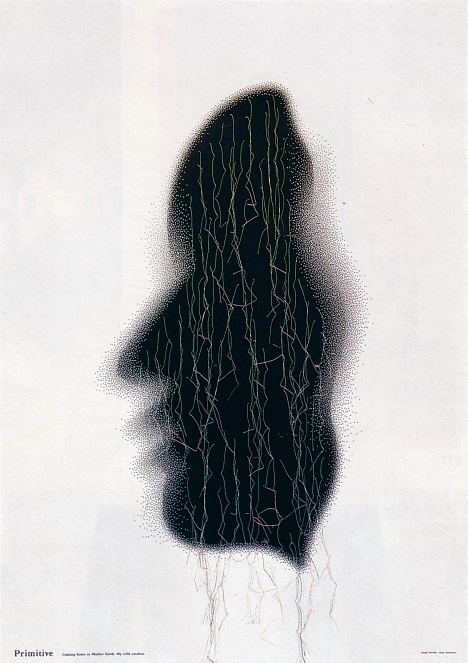
Primitive, Ken Miki, 1993 [+]
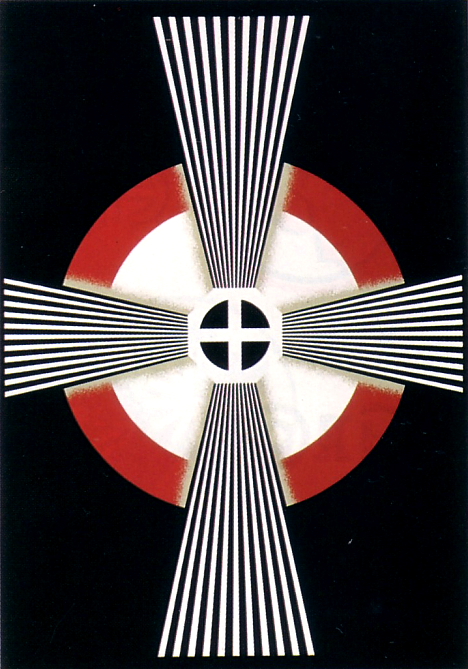
Delicate Technology, Ichiro Higashiizumi, 1991 [+]
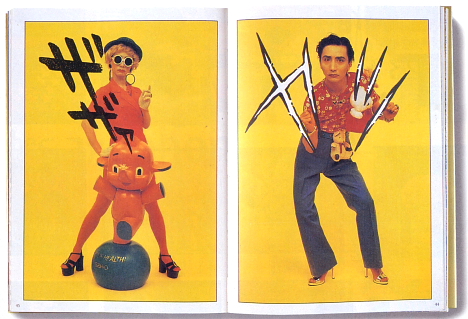
Editorial design for "Dress-up Vol.1," Noriyuki Tanaka, 1994 [+]
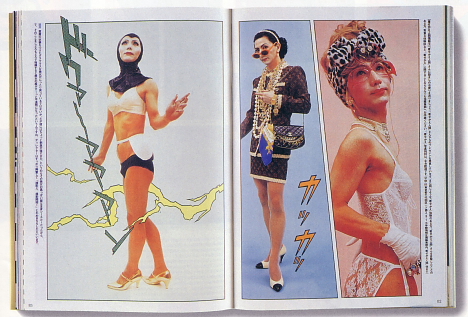
Editorial design for "Dress-up Vol.1," Noriyuki Tanaka, 1994 [+]
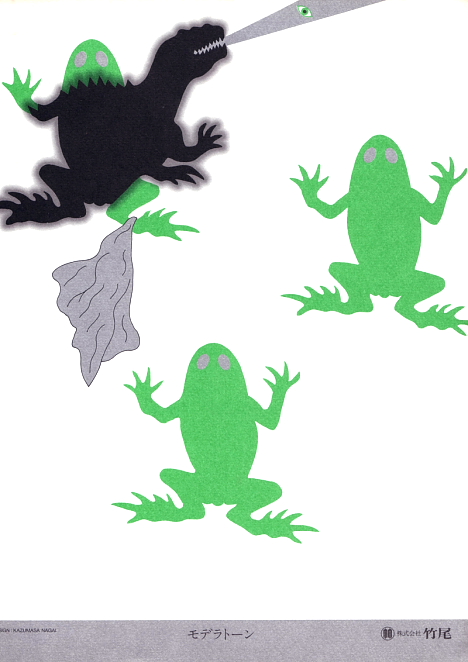
Modera Tone, Kazumasa Nagai, 1995 [+]
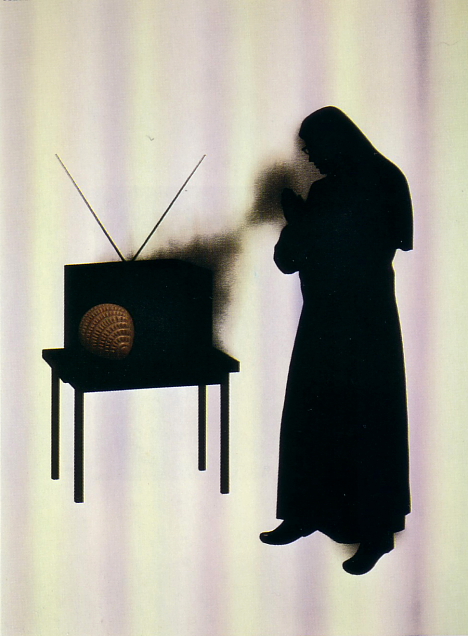
Godiva advertising poster, Osamu Fukushima, 1992 [+]
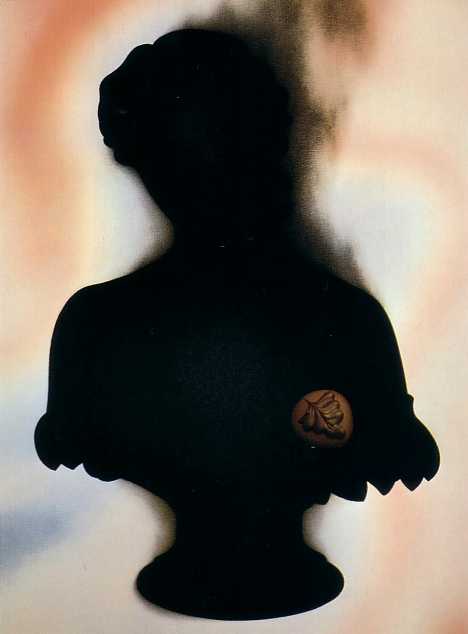
Godiva advertising poster, Osamu Fukushima, 1992 [+]
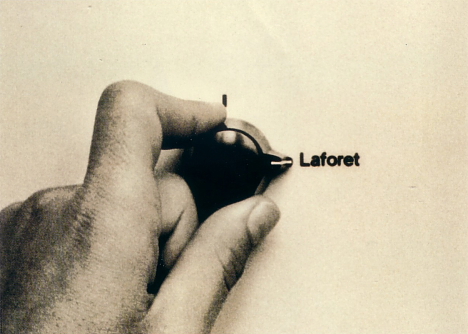
Laforet advertising poster, Takuya Ohnuki, 1991 [+]
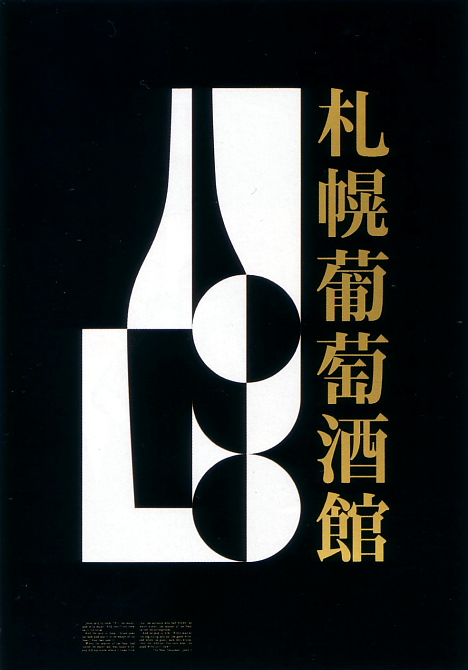
Poster for Sapporo wine museum, Kotaro Hirano [+]
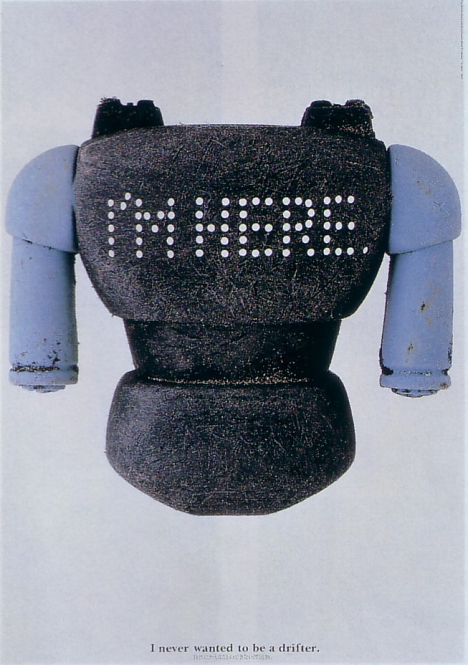
Poster for "Life" exhibition, Osamu Fukushima, 1992 [+]
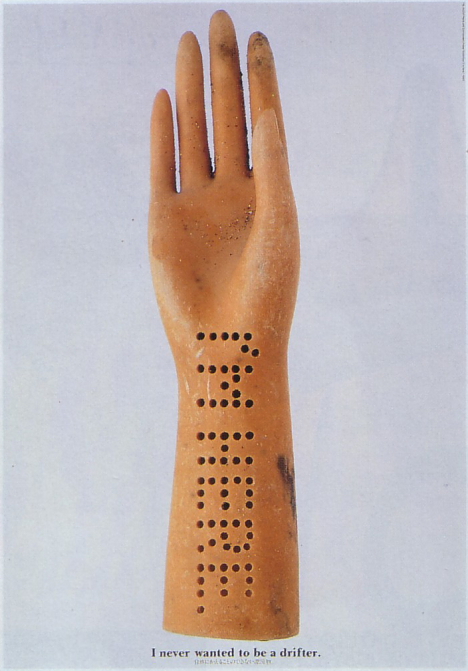
Poster for "Life" exhibition, Osamu Fukushima, 1992 [+]
Several yōkai (Japanese folk monsters) inhabit the upstairs closet at the Kitarō Chaya teahouse in Chōfu (Tōkyō). Visible through peepholes in the door, these traditional monsters -- which are based on old folktales from across Japan -- appear in the popular GeGeGe no Kitarō manga/anime by Shigeru Mizuki, a long-time resident of Chōfu. (Click the [+] to enlarge each image.)
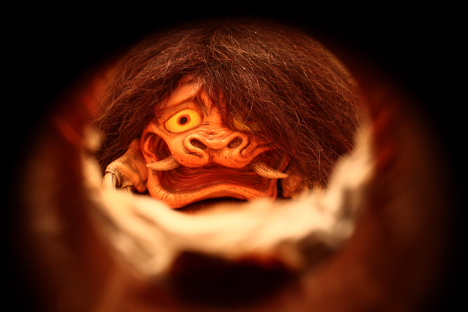
Otoroshi [+]
The Otoroshi, a hairy creature depicted in Edo-period books and picture scrolls, perches atop the gates to shrines and temples, waiting to snatch up impious and ill-intentioned people passing below. [More]
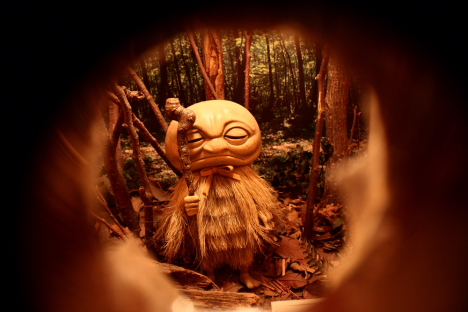
Abura-sumashi [+]
The Abura-sumashi (lit. "Oil Presser"), a folk monster from Kumamoto prefecture known for harassing mountain travelers, is believed to be the reincarnated spirit of an oil thief. Long ago, oil was essential for lighting and heating homes, and the divine punishment for people guilty of stealing this valuable commodity -- particularly from temples and shrines -- was reincarnation as a yōkai. [More]
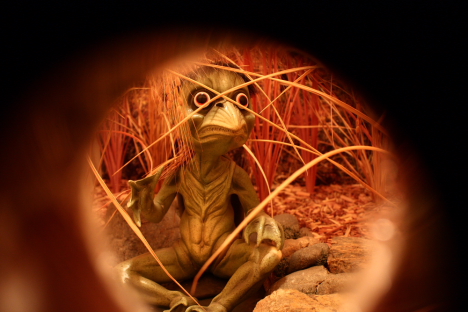
Kappa [+]
The Kappa, probably the most well-known yōkai in Japan, is a mischievous and often dangerous river imp. [More]
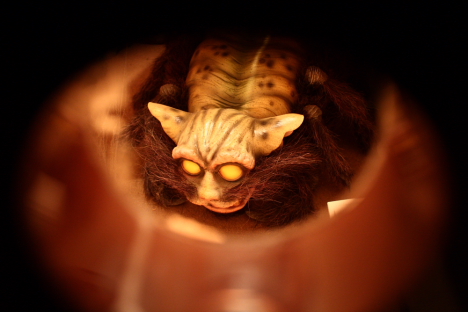
Tsuchigumo [+]
The Tsuchigumo is a large blood-sucking spider sometimes found under the floorboards of old houses. Details about this creature vary from tale to tale, and some theories suggest the monster's origins can be traced back to the exaggerated and embellished stories of encounters with mountain-dwelling people of ancient Japan, who were also referred to as "tsuchigumo" (lit. "ground spiders"). [More]
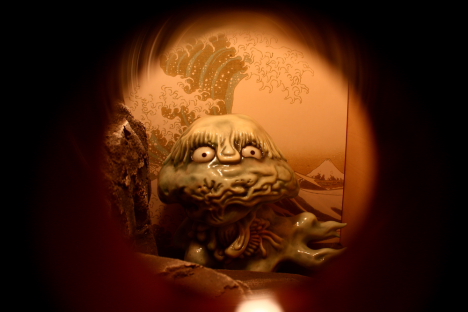
Kurage no Hinotama [+]
The Kurage no Hinotama is a jellyfish-shaped fireball (will-o-wisp) found near the sea. An account from the mid-18th century tells of a samurai who encountered one such ghostly flame on a warm breezy night at Zenshoji temple in Ishikawa prefecture. The man tried to slash the floating apparition with his sword, but to no avail. Unscathed by the attack, the fireball discharged a sticky red sap-like substance onto the man's face. [More]
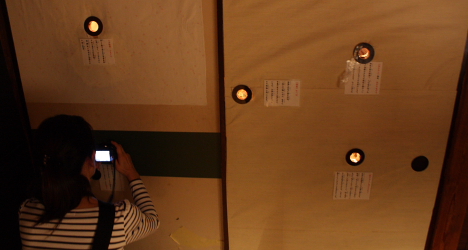
Peepholes in the closet doors upstairs
* * * * *
In addition to the small collection of yōkai art upstairs, the Kitarō Chaya includes a gift shop and a tiny cafe that serves GeGeGe no Kitarō-themed drinks and snacks. The teahouse is located just outside the main entrance to Jindaiji temple, which is a 20-minute bus ride from Chōfu station (bus #34, north side of station, 200 yen).
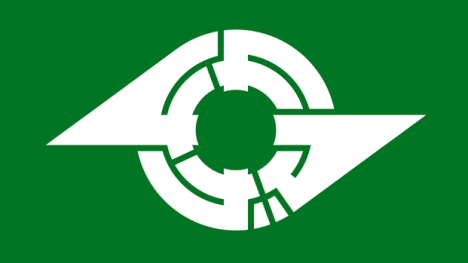
[Typographic logo for Kamagaya (Chiba) spells town name in katakana]
Japanese town logos -- official symbols designed to communicate the identity of each municipality -- come in a vast array of shapes and colors. Many of these municipal symbols incorporate typographical elements (particularly kanji, hiragana, katakana, and Roman letters) into their designs. In most cases, the stylized characters are straightforward and easy to spot (even if you don't read Japanese), but sometimes you have to bend your eyes to see them. The more complex logos encode the name of the town into a puzzle-like symbol that begs to be deciphered. Here are a few typographic town logos that make clever use of hiragana and katakana characters. (The examples are arranged in Japanese alphabetical order and include a mixture of both alphabets.)
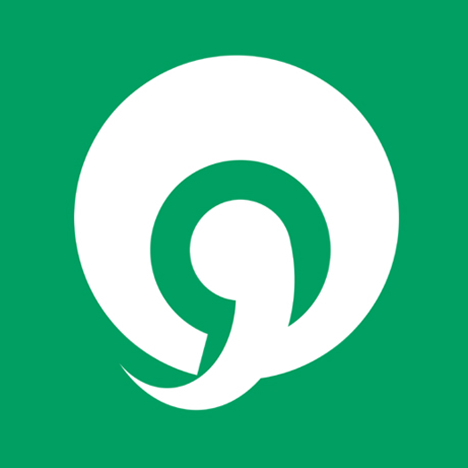
[Abiko, Chiba]
A: Abiko's logo uses a stylized katakana ア (a) that symbolizes Lake Tega.
* * * * *
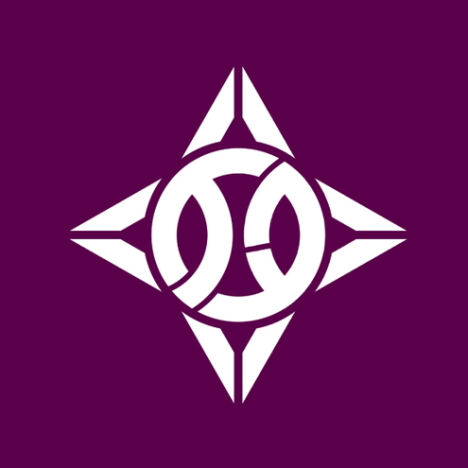
[Itabashi, Tokyo]
I: The picture-puzzle logo for Tokyo's Itabashi ward consists of the katakana イタ (ita) surrounded by four (shi) katakana ハ (ha) -- the katakana ハ (ha) is a variant of バ (ba). Together, the elements express the name "Itabashi" ("ita" + "ha" + "shi").
* * * * *
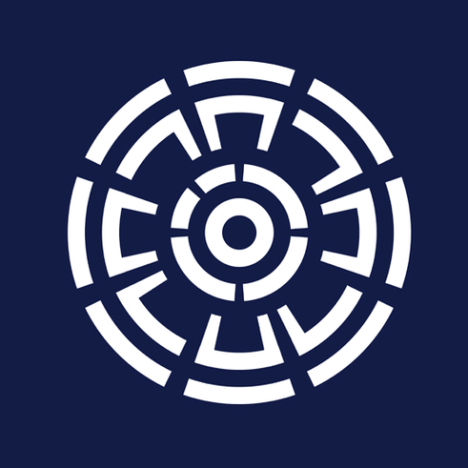
[Urakawa, Hokkaido]
U: In Urakawa's design, a stylized kanji 河 (kawa) is surrounded by four sets of the katakana ウラ (ura), which represent the four municipalities that joined together in 1902 to form the current town.
* * * * *
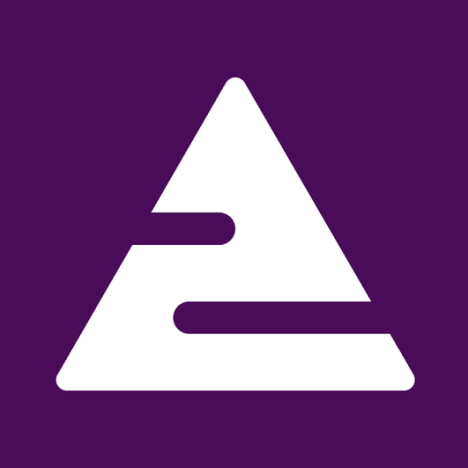
[Ebino, Miyazaki]
E: Ebino's hiragana え (e) is in the shape of Mt. Kirishima.
* * * * *
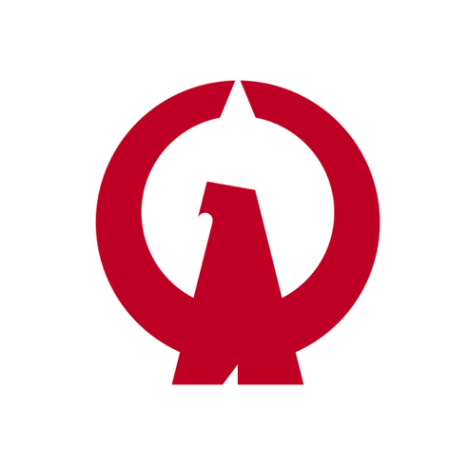
[Owase, Mie]
O: Owase's town logo consists of a katakana オ (o) in the shape of an eagle (pronounced "wase" in the local dialect).
* * * * *
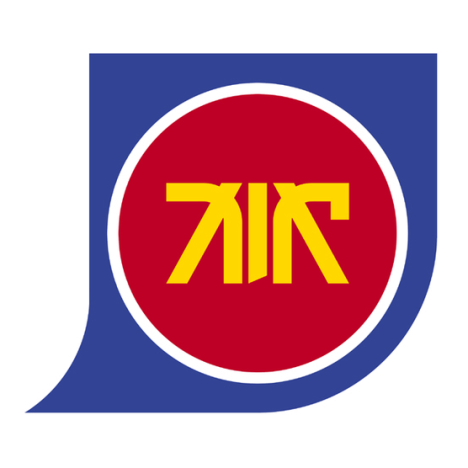
[Kanoya, Kagoshima]
Ka: The blue shape represents the Osumi peninsula, and the red circle with the gold katakana カノヤ (Kanoya) represents the city.
* * * * *
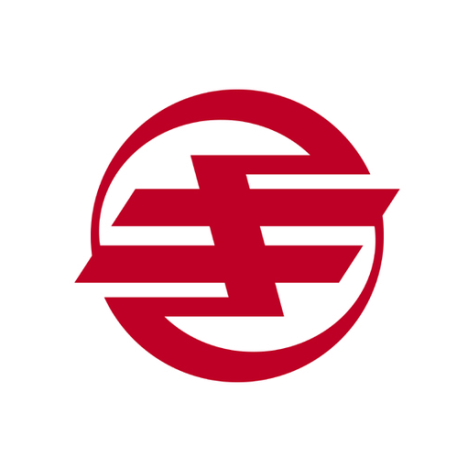
[Kikai, Kagoshima]
Ki: The logo for Kikai consists of a stylized hiragana き (ki).
* * * * *

[Kumamoto, Kumamoto]
Ku: Kumamoto's logo is a rounded hiragana く (ku).
* * * * *
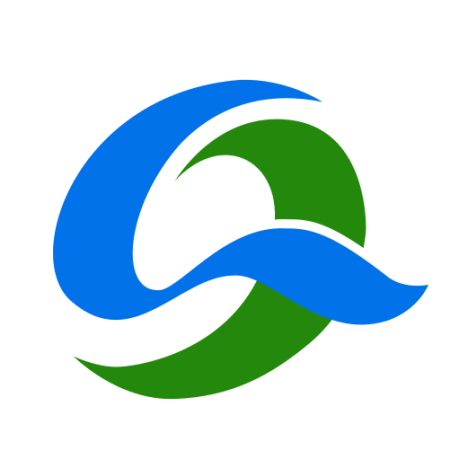
[Kesennuma, Miyagi]
Ke: The logo for Kesennuma consists of a hiragana け (ke).
* * * * *
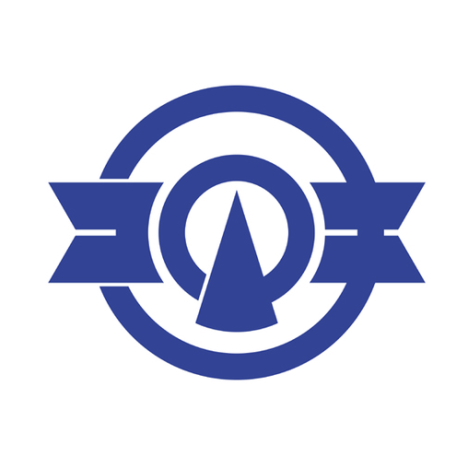
[Komaki, Aichi]
Ko: The katakana コマキ (komaki) in this logo is designed to represent an airplane engine.
* * * * *
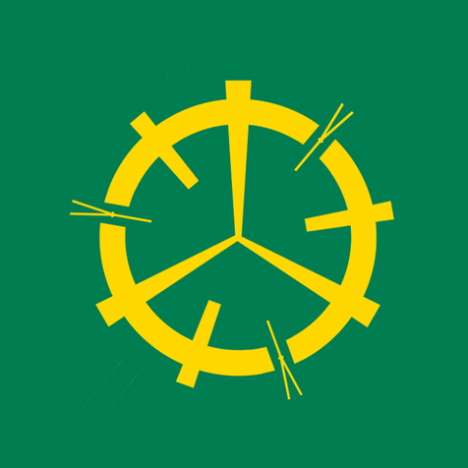
[Misawa, Aomori]
Sa: In Misawa's picture-puzzle logo, the three (mi) katakana サ (sa) form a ring (wa). The Y-shaped objects are pine needles.
* * * * *

[Shimonoseki, Yamaguchi]
Shi: Shimonoseki's logo consists of the hiragana しも (shimo) in the shape of a puffer fish.
* * * * *
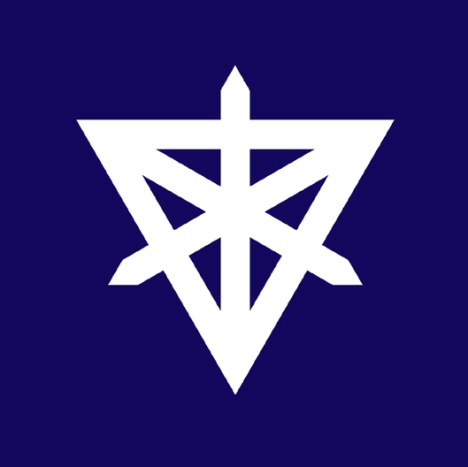
[Sumida, Tokyo]
Su: This symbol for Tokyo's Sumida ward is composed of the katakana ス (su).
* * * * *
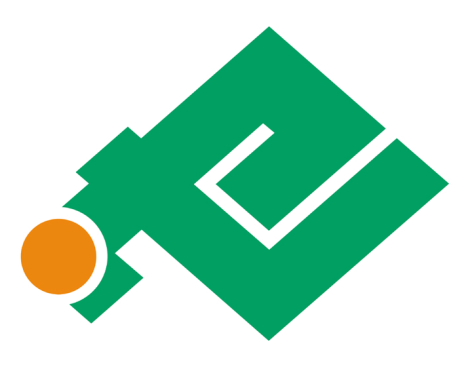
[Setana, Hokkaido]
Se: The katakana せ (se) is in the shape of Hokkaido, and the circle represents the town's location on the map.
* * * * *
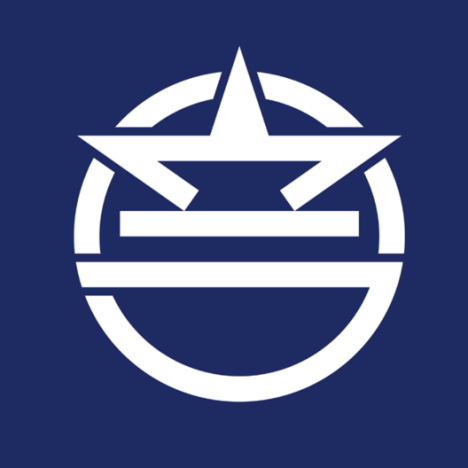
[Urasoe, Okinawa]
So: The logo for Urasoe is said to incorporate the katakana ウラソエ (Urasoe), though the ソ (so) and エ (e) are difficult to see.
* * * * *
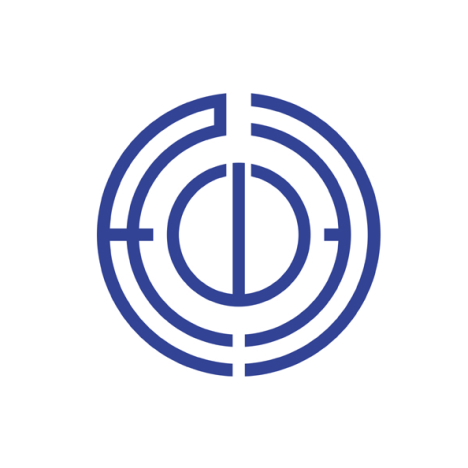
[Tateyama, Chiba]
Ta: Tateyama's logo consists of the katakana タ (ta) on the left, テ (te) on the right, and the kanji 山 (yama) in the center.
* * * * *
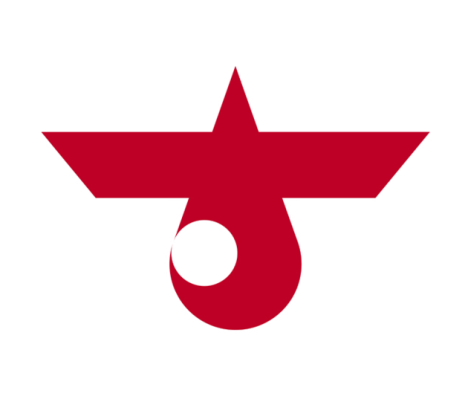
[Chitose, Hokkaido]
Chi: In Chitose's logo, the hiragana ち (chi) is shaped like an airplane.
* * * * *
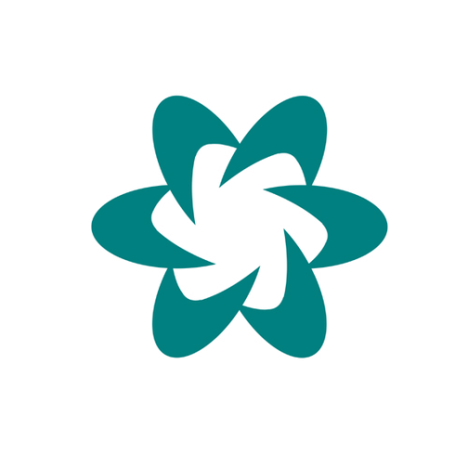
[Tsushima, Nagasaki]
Tsu: The six hiragana つ (tsu) in this logo represent the six municipalities that merged in 2004 to form the current city.
* * * * *

[Toride, Ibaraki]
Te: Toride's logo incorporates the katakana トリテ (torite). デ (de) is a variant of テ (te).
* * * * *
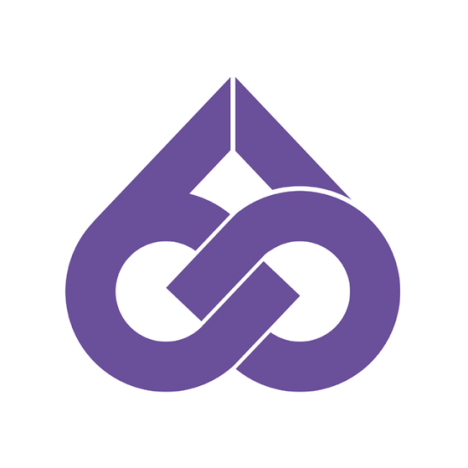
[Tōkai, Aichi]
To: The logo for Tōkai uses the hiragana とう (tō).
* * * * *
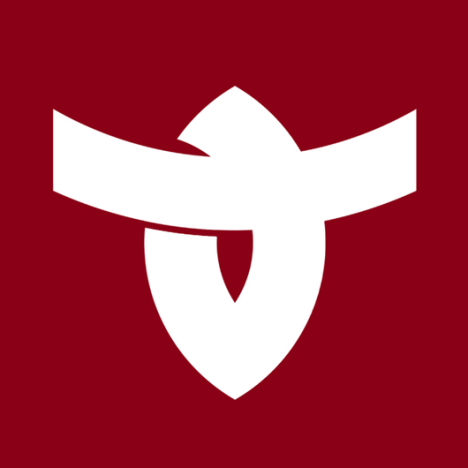
[Nankoku, Kochi]
Na: In Nankoku's logo, the katakana ナ (na) resembles a pair of wings.
* * * * *
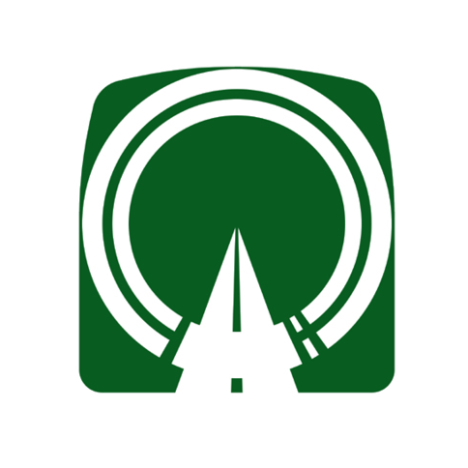
[Niiza, Saitama]
Ni: Niiza's logo incorporates the katakana ニ (ni) and ザ (za).
* * * * *

[Numazu, Shizuoka]
Nu: The logo for Numazu depicts the katakana ヌ (nu) with pine needles.
* * * * *

[Nerima, Tokyo]
Ne: The logo for Tokyo's Nerima ward consists of a katakana ネ (ne) with a horseshoe-shaped center -- a reference to the "horse" kanji 馬 (ma) in Nerima.
* * * * *
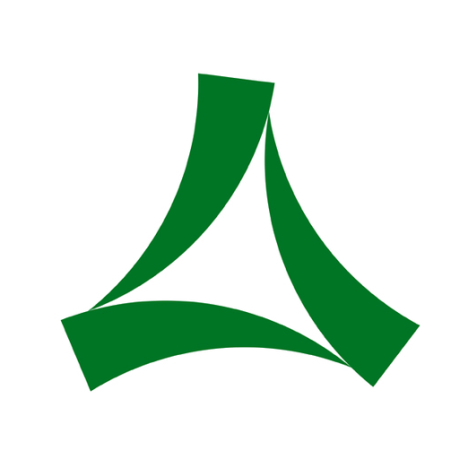
[Minoo, Osaka]
No: Minoo's picture-puzzle logo consists of three (mi) katakana ノ (no).
* * * * *
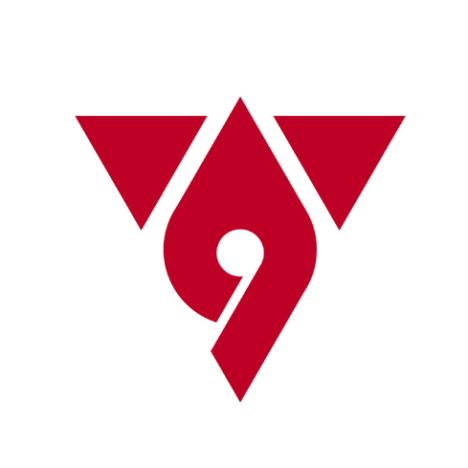
[Hadano, Kanagawa]
Ha: The logo for Hadano consists of the katakana ハタノ (hatano) drawn to resemble wings. ダ (da) is a variant of タ (ta).
* * * * *
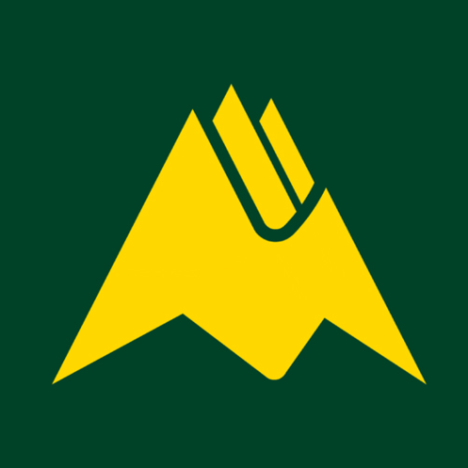
[Biei, Hokkaido]
Hi: Biei's logo design features the hiragana び (bi) in the shape of Mt. Tokachi. び (bi) is a variant of ひ (hi).
* * * * *
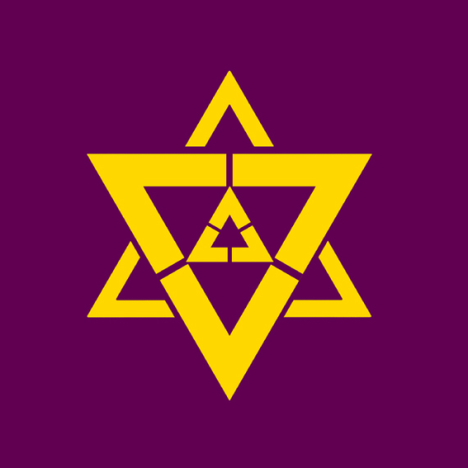
[Fukuchiyama]
Fu: The picture-puzzle logo for Fukuchiyama incorporates nine (ku) katakana フ (fu).
* * * * *
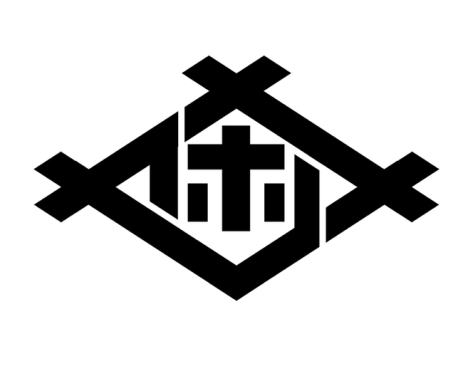
[Sasebo, Nagasaki]
Ho: Sasebo's logo is drawn with the katakana サセホ (Saseho). ホ (bo) is a variant of ボ (ho).
* * * * *
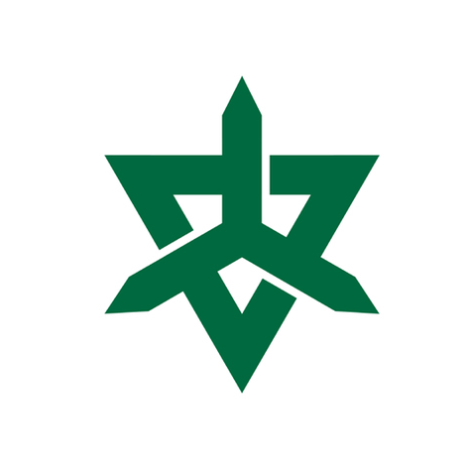
[Higashi-Matsuyama, Saitama]
Ma: This logo design consists of three katakana マ (ma). The symbol as a whole is meant to represent the kanji 東 (higashi), as well as the kanji 山 (yama).
* * * * *

[Minato, Tokyo]
Mi: The design for Tokyo's Minato ward features a stylized version of the hiragana み (mi).
* * * * *
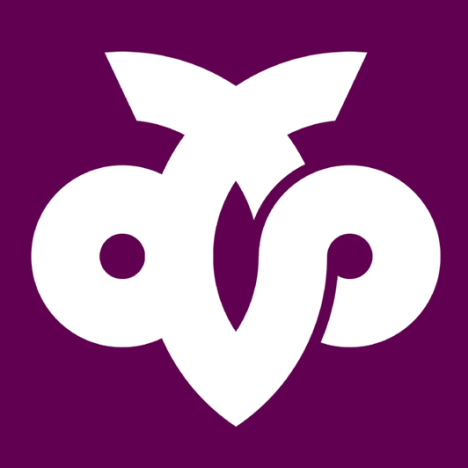
[Mutsu, Aomori]
Mu: Mutsu's symbol consists of the hiragana むつ (mutsu).
* * * * *

[Kameoka, Kyoto]
Me: Kameoka's logo design is said to incorporate letters from three alphabets, including the hiragana かめ (kame), the katakana カメ (kame), the roman letters KA, and others.
* * * * *
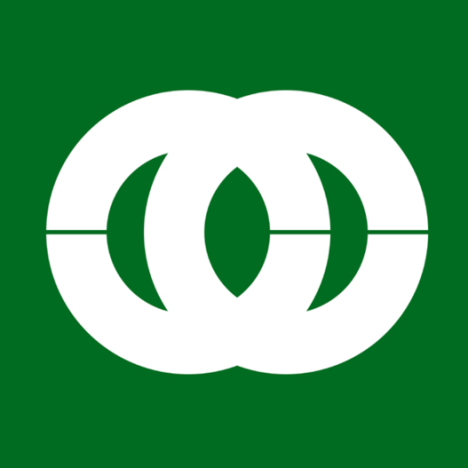
[Mobara, Chiba]
Mo: Mobara's town symbol is said to incorporate a stylized version of the hiragana も (mo), though it is difficult to make out.
* * * * *
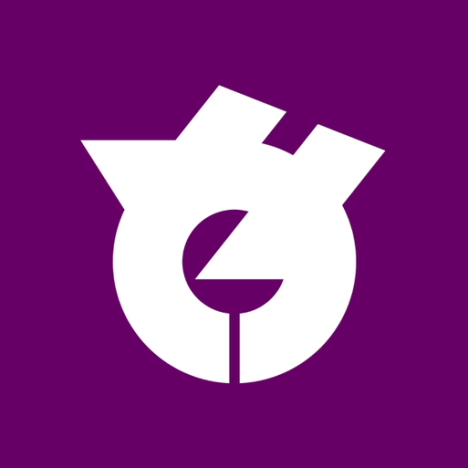
[Yachiyo, Chiba]
Ya: The logo for Yachiyo consists of the hiragana や (ya).
* * * * *
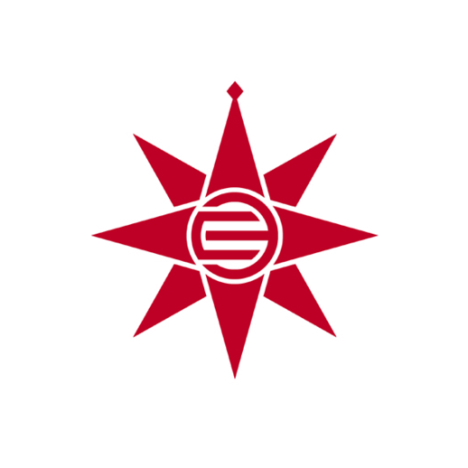
[Yokosuka, Kanagawa]
Yo: Yokosuka's symbol, which represents a mariner's compass, incorporates the katakana ヨコ (yoko) styled like the Miura clan symbol.
* * * * *

[Omura, Nagasaki]
Ra: Omura's picture-puzzle logo features the kanji 大 (oh) surrounded by six (mu) katakana ラ (ra).
* * * * *
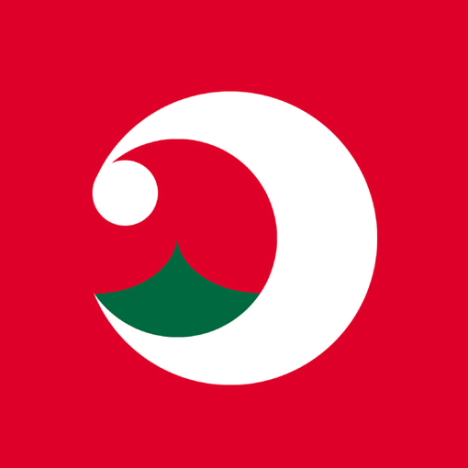
[Rishiri, Hokkaido]
Ri: Rishiri's symbol is said to incorporate the hiragana り (ri), which representing ocean waves, along with the hiragana し (shi), which represents Mt. Rishiri.
* * * * *
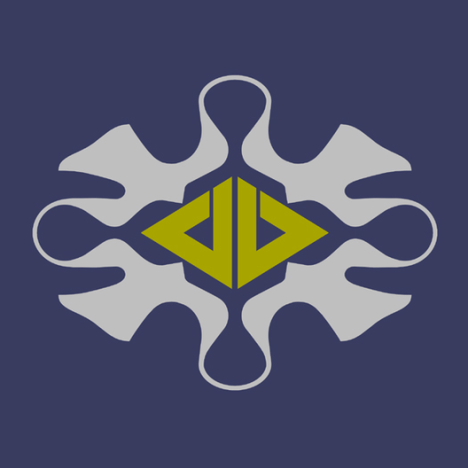
[Rumei, Hokkaido]
Ru: The logo for Rumei consists of the katakana ル (ru) surrounded by four seagulls.
* * * * *

[Rebun, Hokkaido]
Re: Rebun's town symbol incorporates the katakana レ (re).
* * * * *
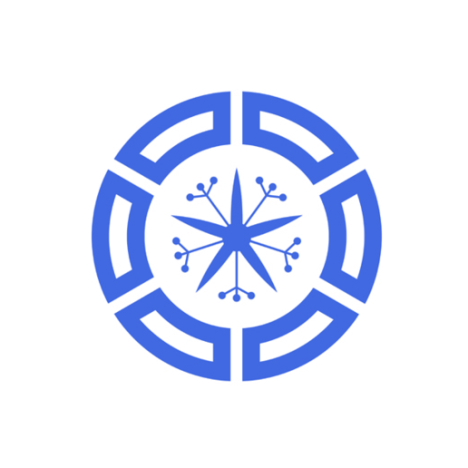
[Muroran, Hokkaido]
Ro: Muroran's picture-puzzle logo consists of six (mu) katakana ロ (ro) surrounding an orchid (ran).
* * * * *
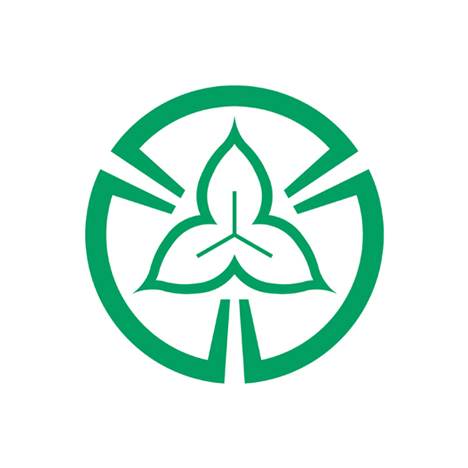
[Tokorozawa, Saitama]
Wa: The picture-puzzle logo for Tokorozawa features a yam (tokoro) surrounded by three katakana ワ (wa). In Japanese, "three" is pronounced "san," which sounds similar to "za."
[More]